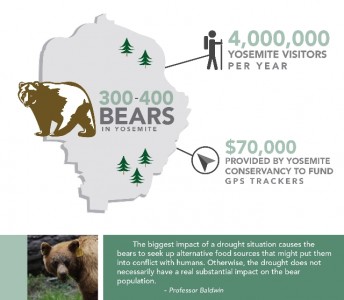
Since September this year Yosemite National Park rangers have begun to install GPS trackers on some of their bear population in efforts to ameliorate the potential negative effects of California’s drought on the bears.
Over the last few months, there have been significantly more bear sightings in human areas than typical for Yosemite Valley. Experts say bears may be seeking alternative food supplies due to limited natural food supply available as a result of the drought.
“During drought conditions, if [bears’] natural food supply becomes relatively limited, they [will] seek for alternative food supplies. It brings them into conflict with humans by them coming into campsites,” said Professor Roger Baldwin of the UC Davis Department of Wildlife, Fish and Conservation Biology.
As a precautionary measure, the park services have put GPS tracker collars on small population of the bears to provide information on bear activities and habits, as well as their movements. The collars are used to monitor specific bears that have shown unnatural behaviors due to their frequent interactions with humans. These interactions have, in fact, increased over the last few months.
“The collars provide us [with] information and [help us to] keep track of these specific bears that we know are coming into camp grounds, or trying to break into houses or trying to get food from humans,” said Kari Cobb, Yosemite National Park’s public affairs representative.
The GPS trackers were funded by Yosemite Conservancy, who donated $70,000 to help the park in their efforts.
“We [want to fulfill] our mission of preserving and protecting Yosemite National Park and [enhance] the visitor experience,” said Jennifer Miller, Yosemite Conservancy’s media representative.
In addition, the organization has funded projects and programs to support the national park which includes bear management programs such as renting bear-proof food canisters used by visitors of the park.
However, before the GPS trackers came into play, rangers have long relied on limiting negative human-bear interaction through the installment of bear lockers, which keep bears out from visitors’ or campers’ perishable goods and other belongings.
The park, which is home to around 300-500 bears, has installed approximately 2,000 bear lockers over the years. Visitors are required to use these bear lockers which are found in campsites and frequently used parking areas.
“[The bears] may come here and [be] more visible, but they do not have any more chances to get food,” Cobb said.
Additionally, visitors are usually informed on how to handle interactions with bears through educational information sessions and signs that are placed around the park. Since these regulations were put in place, bear raids have decreased considerably. In the late 1990s, there were several hundreds of bear raids a year, but in 2013 there were only 10.
“Sometimes we still experience [the bears] raiding vehicles…[when] people don’t put their food in the lockers and keep them in their vehicles,” Cobb said.
“They have a very keen sense of smell…I’ve heard from 10 times to a 100 times more sensitive than a bloodhound,” said Baldwin.
However, Baldwin believes the bear population will adapt, despite the drought potentially affecting food availability. He says bears are used to finding new sources of food, and can instinctually determine locations with the most berries, acorns and oats. More specifically, when the production of bear food is limited due to the drought on higher elevation, bears are used to moving to lower elevation where food sources are more available.
“Bear foods are usually patchy, so they are constantly moving around trying to find those different patches,” said Baldwin.
It is important to note, still, that there can be negative effects on the bear population if the drought persists for a prolonged time period.
“If the drought was of a really long duration and the bears were not able to get all the necessary food items…then it could, theoretically, have a negative impact to the recruitment and population,” said Baldwin.
With efforts from rangers and cooperative visitors, sources hope that the drought will not affect the population of the bears in Yosemite. Bears are one of the main attractions for visitors of the Yosemite park and visitors frequently see them during their stay.
Park rangers, nature conservationists and park visitors alike stress the importance of maintaining bear population and diversity. Carson Graves, a first-year political science major at UC Davis, went on a trip to the national park last September. He describes how important it is to see wildlife in its natural habitat.
“When I saw the bear, I was in awe. I only saw [from] a distance, but I felt that it was the perfect representation of the natural ecosystem around us and it’s a perfect reminder that we have a symbiotic relationship [with animals],” said Graves.



